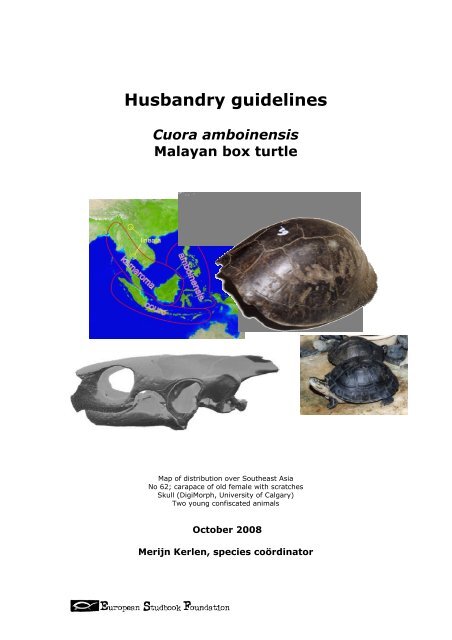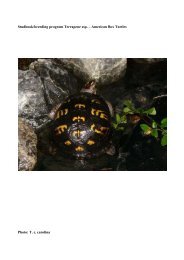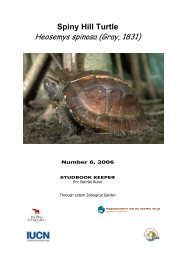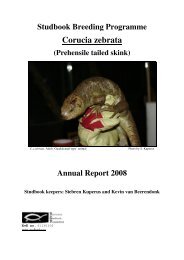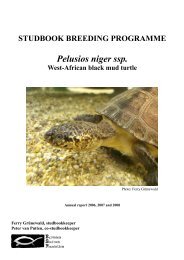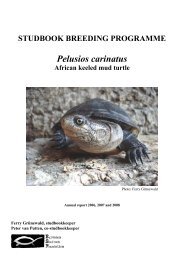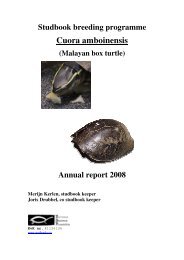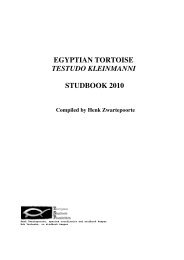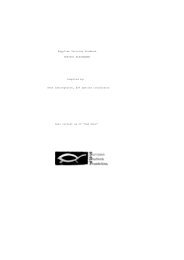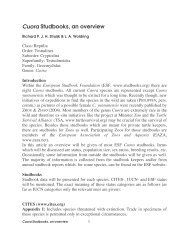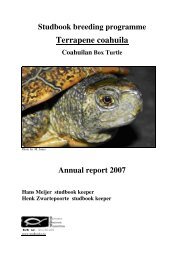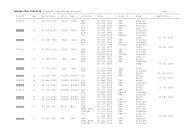Husbandry guidelines â Cuora amboinensis
Husbandry guidelines â Cuora amboinensis
Husbandry guidelines â Cuora amboinensis
- No tags were found...
Create successful ePaper yourself
Turn your PDF publications into a flip-book with our unique Google optimized e-Paper software.
<strong>Husbandry</strong> <strong>guidelines</strong><strong>Cuora</strong> <strong>amboinensis</strong>Malayan box turtleMap of distribution over Southeast AsiaNo 62; carapace of old female with scratchesSkull (DigiMorph, University of Calgary)Two young confiscated animalsOctober 2008Merijn Kerlen, species coördinator
<strong>Husbandry</strong> <strong>guidelines</strong> – <strong>Cuora</strong> <strong>amboinensis</strong>DistributionThe geographic distribution of <strong>Cuora</strong> <strong>amboinensis</strong> is the regionsouth east Asia (Nicobar Islands, eastern India , Bangladesh, SriLanka, Myanmar, Thailand, Cambodia, Laos, Vietnam, Malaysia,Singapore, Philippines, Indonesia).The animals prefer slow moving bodies of fresh water, such asponds, marshes, swamps, and rice paddies. <strong>Cuora</strong> <strong>amboinensis</strong><strong>amboinensis</strong> is more aquatic than <strong>Cuora</strong> <strong>amboinensis</strong> kamaroma.3
<strong>Husbandry</strong> <strong>guidelines</strong> – <strong>Cuora</strong> <strong>amboinensis</strong>SubspeciesSince 1997 four different subspecies of <strong>Cuora</strong> <strong>amboinensis</strong> havebeen described;<strong>Cuora</strong> <strong>amboinensis</strong> <strong>amboinensis</strong><strong>Cuora</strong> <strong>amboinensis</strong> couro<strong>Cuora</strong> <strong>amboinensis</strong> kamaroma<strong>Cuora</strong> <strong>amboinensis</strong> lineataThese subspecies can be separated by a combination of the shapedifferences of the carapace, the pattern of the plastron and thepattern of the stripes on the head. The easiest method is thecombination of shapes together with the pattern of the plastron.For all subspecies the maximum sizes of the carapace are about;length = 22 cm (9 inch), height 11 cm (4,5 inch), width 15 cm (6inch). Sizes depends on subspecie, age and feeding pattern. Nodifferences are known for maximum length and width for thedifferent subspecies, except height which depends on the subspecie.No difference on carapace size is known between females andmales. Males have concave plastrons and longer thicker tails.<strong>Cuora</strong> <strong>amboinensis</strong> <strong>amboinensis</strong> (Daudin, 1802)Flat carapace, good swimmer, also diving. Usually many dark areason plastron for all scutes.Very common in the 70’s, 80’s and 90’s.<strong>Cuora</strong> <strong>amboinensis</strong> couro (Schweigger, 1812)Intermediate characteristics between <strong>amboinensis</strong> and kamaroma.Less common in 70’s, 80’s and 90’s. Nowadays rare.<strong>Cuora</strong> <strong>amboinensis</strong> kamaroma (Rummler & Fritz, 1991)Domed carapace, bad swimmer (diving). Smaller or no dark areason plastron for all or some scutes.Most common since 2000.4
<strong>Husbandry</strong> <strong>guidelines</strong> – <strong>Cuora</strong> <strong>amboinensis</strong><strong>Cuora</strong> <strong>amboinensis</strong> lineata (McCord & Philippen, 1998)Same characteristics as kamaroma but a carapace with a lightcoloured middorsal stripe and often light coloured lateral stripes.Only a few specimens are known.EnvironmentThe <strong>Cuora</strong> <strong>amboinensis</strong> is very strong and can handle lowtemperatures. The temperatures differ on the natural origin of theanimals (location, attitude, etc.). However it’s preferable to use anaerial temperatures between 18°C and 25°C (64°F - 77°F). Thewater temperature should never be lower as the aerial temperature.<strong>Cuora</strong> <strong>amboinensis</strong> prefer to bask below a spot light where thetemperature can be 35°C (95°F). Additional uv light is only neededfor herbivorous <strong>Cuora</strong>’s.An aquarium of 200x60 cm (80x25 inch) can contain an absolutemaximum of 6 adults, a maximum of 4 is preferred. Sometimesmales should be separated from females because of the malesaggression due to their urge for mating.Depending on the subspecies and their swimming capacities 30%(C.a.a.) – 60% (C.a.k.) of the total surface should contain humidsubstrate. The animals also like a muddy area with a water level ofa few centimeters. This muddy area is part of the surfacementioned above.The substrate could contain spaghnum, peat moss, leafs, sand andsmall gravel. For egg laying the depth of the substrate should be atleast 10 cm (4 inch).The water area should be cleaned by an external filter with a pump,preferable a biological filter. Water depth should be at least 20 cm(8 inch). The bigger the water volume the better the (biological)filter will be.On hot days (> 25°C (77°F) daytime and > 20°C (68°F) nighttime)<strong>Cuora</strong> <strong>amboinensis</strong> can be kept outside. Especially the naturalsunshine, and uv, will be appreciated. Beware of the climbingcapacities of the animals!5
<strong>Husbandry</strong> <strong>guidelines</strong> – <strong>Cuora</strong> <strong>amboinensis</strong>DietIn nature <strong>Cuora</strong> <strong>amboinensis</strong> is almost herbivorous. In captivitythey are omnivorous and really prefer all kinds of fruit (apple, pear,bananas), vegetables (dandeleon, lettuce, tomatoe, endive,chicory), meat (cow, chicken, canned cat/dog food) and fish (dried,fresh, shrimps). If available also live food is accepted (snails,worms, crickets).Additional supplements is recommended (commercialcalcium/vitamin additive) depending on the kind of food offered. Forcanned cat/dog food extra supplements are not recommendedbecause these are already added.Feeding 2-3 times a week is fine. For canned food a maximum oftwice a month is recommended because this food is rich on fat.6
<strong>Husbandry</strong> <strong>guidelines</strong> – <strong>Cuora</strong> <strong>amboinensis</strong>References Daudin, F. M. 1802. Histoire naturelle, générale et particulièredes reptiles. 2. F. Dufart, Paris. 432 pp. Ernst, C.H. & R.W. Barbour, 1989. Turtles of the world: 147. Filella, E., 1999. <strong>Cuora</strong> <strong>amboinensis</strong> and its subspecies.Reptilia (English edition) 9: 65-69. Gorman, G. C. 1973. The chromosomes of the Reptilia, acytotaxonomic interpretation. In: A. B. Chiarelli and E.Capanna (eds.), Cytotaxonomy and Vertebrate Evolution, pp.349-424. Academic Press, New York. Hall, G., 1995. Asian Box Turtles. Reptile & AmphibianMagazine, May/June: 110-116. Hofstra, J., 1989. De kweek met de ambonesewaterdoosschildpad (<strong>Cuora</strong> <strong>amboinensis</strong>). Lacerta 47(6): 162-164. Hofstra, J., 1994. Kweken met de Ambonese doosschildpad(<strong>Cuora</strong> <strong>amboinensis</strong>). Lacerta 53(1): 18-22. Inskeep, R. 1984a. A note on the captive breeding of the boxturtle <strong>Cuora</strong> ambioinensis (Daudin, 1802). British J. Herpetol.6: 383-384. Inskeep, R. 1984b. Second breeding of <strong>Cuora</strong> ambionensis(Daudin 1802). Brit. Herpetol. Soc. Bull. 9: 28. Iverson, J. B. 1992. A Revised Checklist with DistributionMaps of the Turtles of the World. Privately printed. PaustPrinting, Richmond, Indiana: 363. Khan, M. A. R. 1982. Chelonians of Bangladesh and theirconservation. J. Bombay Natur. Hist. Soc. 79: 110-116. McCord, W.P. & H-D. Philippen, 1998. A new subspecies ofbox turtle, <strong>Cuora</strong> <strong>amboinensis</strong> lineata. Reptile Hobbyist,Neptune City, N.J, 3(7): 51 – 58. Moll, E. O., and J. Vijaya. 1986. Distributional records forsome Indian turtles. J. Bombay Natur. Hist. Soc. 83: 57-62. Mudde, P.M., 1987. Voortplanting van de Ambonesewaterdoosschildpad (<strong>Cuora</strong> <strong>amboinensis</strong>) in het terrarium.Lacerta 45(5): 70-80. Mudde, P.M., 1999. Breeding the Amboina Box Turtle. <strong>Cuora</strong><strong>amboinensis</strong> kamaroma. Reptilia (English edition) 9: 60-64. Pritchard, P.C.H., 1979. Encyclopedia of turtles: 211-213. Rummler, H.J. & U. Fritz, 1991. Geographische Variabilität derAmboina Scharnierschildkröte <strong>Cuora</strong> <strong>amboinensis</strong> mitBeschreibung einer neuen Unterart, C.a.kamaroma.Salamandra 27(1): 17-45. Saxena, A. 1994. Captive husbandry of the Malayan box turtle(<strong>Cuora</strong> <strong>amboinensis</strong> ) from the Nicobar Islands. Hamadryad19: 93-94.7
<strong>Husbandry</strong> <strong>guidelines</strong> – <strong>Cuora</strong> <strong>amboinensis</strong> Schweigger, A. F. 1812. Monographiae Cheloniorum.Königsberg. Arch. Naturwiss. Math. 1: 271-368, 406-458. Smith, M. A. 1931. The fauna of British India, includingCeylon and Burma. Reptilia and Amphibia, vol. 1, Loricata andTestudines. Taylor and Francis, London. 185 pp. Taylor, E. H. 1920. Philippine turtles. Philippine J. Sci. 16:111-144. Vetter, H. & P.P. van Dijk, 2006. Turtles of the World Vol. 4:East an South Asia; Schildkröten der Welt Band 4: Ost- undSüdasien. Edition Chimaira, Frankfurt am Main, 2006: 160. Welch, K.R.G., 1994. Turtles, Tortoises and Terrapines. AChecklist: 17-19.8


